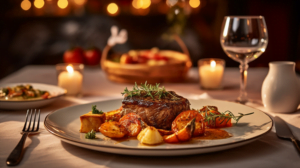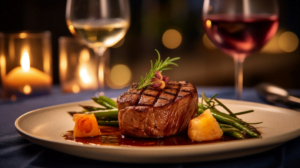Savoring Digital Success: How Restaurants Can Benefit from a Website and SEO
I don’t know about you, but if you’re anything like my wife and I, if we can’t find a website for a restaurant we Will Not Go There. In today’s highly competitive and fast-paced restaurant industry, having a strong online presence is crucial to staying ahead of the game. The rise of online food ordering, review sites, and social media has made it more important than ever for restaurants to invest in a well-designed website and effective SEO strategies. These efforts can significantly increase visibility, attract more traffic, and ultimately boost business growth. Embracing digital marketing techniques will ensure that restaurants remain relevant and accessible in an increasingly digital world.
Why Restaurants Need a Website
Showcasing menu offerings and ambiance
A professional website allows restaurants to effectively showcase their menu offerings and unique ambiance. High-quality images and descriptions of dishes, along with information about the restaurant’s history, concept, and team, can entice potential customers and set the restaurant apart from competitors. In addition, a website can serve as a platform to highlight special events, promotions, and seasonal menu changes.


Building credibility and trust
A polished and informative website can help to establish credibility and trust with potential customers. By providing contact information, hours of operation, and customer testimonials, restaurants can reassure potential patrons that they are reliable and worth visiting. A website with consistent and professional branding also makes a strong impression on visitors, helping to create a positive brand image.
Enhancing customer convenience
A user-friendly website can make it easier for customers to find essential information, make reservations, and place online orders. By integrating online booking and ordering systems, displaying current menus, and providing clear directions, restaurants can offer a seamless and convenient experience for their guests.
Reaching a broader audience
By having a website, restaurants can reach a much wider audience than they would through traditional marketing methods alone. A strong online presence can help to attract local customers as well as tourists and out-of-town visitors. By targeting specific geographic areas and demographics, a website can bring in valuable leads and potential patrons.
III. Essential Website Elements for Restaurants
Responsive design for mobile devices
As many people now use their smartphones to search for dining options, it’s crucial for a restaurant’s website to be optimized for mobile devices. A responsive design ensures that the site looks and functions well on screens of all sizes, providing a seamless user experience. Moreover, search engines like Google prioritize mobile-friendly websites, so having a responsive design can improve search engine rankings.
Clear and concise navigation
An easy-to-navigate website helps users find the information they need quickly and efficiently. Restaurants should use clear headings and intuitive menus to guide visitors through their site. A well-structured website with a clear hierarchy not only enhances user experience but also helps search engines crawl and index the site more effectively.
High-quality visuals and branding




High-quality visuals and consistent branding can help to create a professional image for restaurants. Photos of dishes, the dining area, and the team can give potential patrons a better understanding of the restaurant’s atmosphere and offerings. Additionally, using a consistent color scheme, typography, and logo across the website can reinforce brand identity and make the site more memorable.
Informative and engaging content
Informative and engaging content is key to keeping visitors on the site and converting them into customers. Restaurants should provide valuable information about their menu offerings, the inspiration behind their dishes, and any unique selling points to demonstrate their passion and commitment to quality. Creating a content plan that highlights the restaurant’s story, vision, and culinary expertise can help engage and retain website visitors.
IV. Search Engine Optimization (SEO) for Restaurants
Keyword research and targeting
Restaurants should research and target relevant keywords to improve their website’s visibility in search engine results. By focusing on local and industry-specific terms, they can attract potential customers who are actively searching for dining options. Conducting comprehensive keyword research and analyzing competitors’ websites can help restaurants identify high-potential keywords to target in their content, titles, and meta descriptions.
On-page optimization techniques
Title tags and meta descriptions: These elements provide a brief summary of the page’s content and help search engines understand its relevance. Restaurants should include targeted keywords in their title tags and meta descriptions to improve search visibility. Crafting compelling and unique title tags and meta descriptions can also encourage users to click on the search result, driving more traffic to the website.
Header tags and content structure: Using header tags and well-structured content can make the website more accessible and easier to navigate for both users and search engines. Organizing content using logical headings and subheadings not only improves readability but also helps search engines understand the page’s hierarchy and main topics.
Image optimization: Optimizing images by compressing them and adding descriptive alt tags can improve site speed and search engine rankings. Additionally, using keyword-rich file names for images can further enhance the website’s SEO.
Off-page optimization techniques
Building high-quality backlinks: Obtaining links from reputable websites can improve a restaurant’s search engine rankings and credibility. Restaurants can acquire backlinks through strategies like guest blogging, collaborating with local businesses, or participating in industry forums and online communities.
Local SEO and Google My Business: Restaurants should claim and optimize their Google My Business listing, including accurate contact information, service areas, and customer reviews. Ensuring that the listing contains up-to-date information and actively managing customer reviews can help restaurants rank higher in local search results.
Technical SEO considerations
Site speed and performance: Ensuring a website loads quickly and performs well is essential for both user experience and search engine rankings. Restaurants should regularly test their site speed and make necessary improvements, such as optimizing images, minimizing the use of JavaScript, and using content delivery networks (CDNs).
Structured data and schema markup: Implementing structured data and schema markup can help search engines better understand the content on a restaurant’s website, potentially leading to improved search visibility and rich snippets in search results. Schema markup can provide search engines with additional information about the business, such as its address, operating hours, and services offered, which can improve the website’s local SEO performance.
V. Driving Traffic to Restaurant Websites
Content marketing strategies
Blogging and guest posting: Regularly publishing informative blog posts and contributing guest articles to industry-related websites can help restaurants establish themselves as experts in their field while attracting more visitors to their site. Creating a content calendar and consistently producing valuable content can significantly boost organic traffic and brand visibility.
Video and multimedia content: Creating engaging video content, such as behind-the-scenes footage, cooking demonstrations, and customer testimonials, can help restaurants reach a broader audience and increase their online visibility. Sharing videos on platforms like YouTube and social media can further extend the reach of the content and attract more potential patrons.
Social media marketing
Platform selection and targeting: Restaurants should choose social media platforms that are most relevant to their target audience and focus on posting valuable content and engaging with the community. By concentrating on the most effective platforms, restaurants can optimize their efforts and make a more significant impact on their audience.
Engaging with the community: By responding to comments, answering questions, and participating in relevant discussions, restaurants can build rapport with potential customers and increase their brand visibility. Actively engaging with users on social media can also help to gather valuable feedback and insights to improve the business and its offerings.
Email marketing and lead generation
Collecting email addresses: Offering valuable content or incentives, such as a newsletter or promotional discounts, can encourage website visitors to provide their email addresses. By building an email list, restaurants can nurture relationships with potential patrons and maintain communication with existing customers.
Crafting compelling newsletters: Sending regular, engaging newsletters can help restaurants stay top-of-mind with potential customers while providing valuable information and updates on their services. Personalizing newsletters and segmenting the email list based on customer preferences can lead to higher open and click-through rates, ultimately driving more business.
Paid advertising and retargeting
Google Ads and PPC campaigns: Running targeted pay-per-click (PPC) campaigns on Google Ads can help restaurants reach potential customers who are actively searching for dining options. By optimizing ad copy and landing pages for relevant keywords, restaurants can improve their ad performance and increase their return on investment (ROI).
Social media advertising: Utilizing social media advertising platforms, such as Facebook Ads, can help restaurants target specific demographics and reach new audiences. By creating engaging ad creatives and testing different targeting options, restaurants can optimize their ad campaigns for maximum results.
VI. Measuring Success and Analytics
Setting up and using Google Analytics
By installing and using Google Analytics, restaurants can track their website’s performance, understand user behavior, and identify areas for improvement. Regularly monitoring key metrics such as traffic sources, bounce rate, and user engagement can help restaurants make data-driven decisions to optimize their website and marketing strategies.
Tracking key performance indicators (KPIs)
Monitoring KPIs, such as organic traffic, conversion rates, and average session duration, can help restaurants measure the success of their online efforts and identify areas for improvement. Comparing KPIs over time can provide valuable insights into the effectiveness of different marketing strategies and help guide future decisions.
Making data-driven decisions for improvements
Using the insights gained from analytics, restaurants can continuously optimize their website and marketing strategies to attract more customers and drive business growth. By analyzing user behavior, testing different approaches, and iterating on their strategies, restaurants can ensure they are making the most of their online presence.
Final Thoughts
A well-designed website and effective SEO strategies are essential for restaurants looking to thrive in the digital age. By investing in a professional online presence and implementing various marketing strategies, restaurants can unlock new opportunities for growth and success. The time to take action and optimize your online presence is now—don’t miss out on the potential benefits. Establishing and maintaining a strong online presence can make a significant difference in reaching more customers, building trust, and ultimately driving business growth for restaurants in the competitive food industry.
